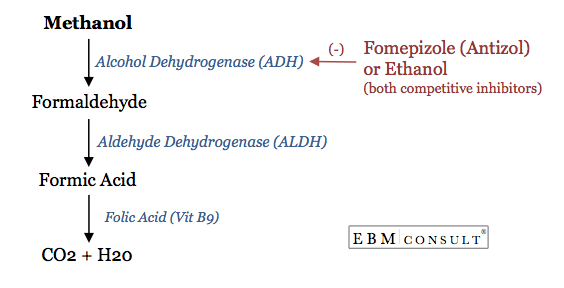Methanol Toxicology - An Overview
Summary:
- Methanol toxicity is important to recognize because of its conversion to acid metabolites that can cause a metabolic acidosis, blindness, and neurologic damage.
- Treatment is multifactorial, but if implemented early can prevent some of these complications.
Editor: Anthony J. Busti, MD, PharmD, FNLA, FAHA
Last Reviewed: August 2015
Methanol Toxicology
|
|---|
- Windshield wiper fluid
- De-Icing products
- Paint removers
- Shoe dyes
- Embalming fluid
- Cosmetic nail products containing methyl acetate
- Inebriation (intoxication)
- Blindness
- Directly toxic to the optic disc and optic nerve
- GI
- Neurologic
(various manifestations)
- Cases of bilateral putamen and caudate nucleus necrosis +/- basal ganglia hemorrhage
- Anion Gap
- Metabolic
Acidosis
- Due to the formation of formic acid and inhibition of cytochrome oxidase that promotes anaerobic metabolism that leads to lactate production.
- Osmol Gap
- Conversion Factor = 3.2
- How to estimate methanol concentration (while waiting for actual level):
- Step 1: Calculate Osm = (2 x Na) + (BUN/2.8) + (Glucose/18) + (Ethanol level/4.6)
- Step 2: Determine Osm Gap = (Measured Osm) - (Calculated Osm)
- If Gap > 15 = abnormal
- If Gap > 25 = very high a give empiric fomepizole (Antizol)
- Step 3: Estimate Methanol Alcohol Concentration (mg/dL) = 3.2 x Osm gap
- General Notes:
- Call or consult with Poison Center 1-800-222-1222
- The half-life of the parent compound (methanol) changed based on situation and concentration. At higher levels follows zero order elimination kinetics.
- No Treatment = 3 hrs (if low levels)
- Fomepizole Treatment = 54 hrs
- Hemodialysis = 2.5 hrs
- GI Decontamination:
- Generally avoided
- Rarely helpful unless very early on (within 15-30 min) since alcohols are rapidly absorbed or co-ingestions and airway is protected
- Fomepizole:
- Competes with methanol for metabolism via alcohol dehydrogenase (ADH) enzyme. Fomepizole has an 8,000 fold greater binding affinity to ADH and thus prevents the metabolism of methanol to toxic acid metabolites.
- Indications:
- Methanol levels > 20 mg/dL
- Reports of ingestion & any 2 of the following (osmol gap > 10-15 mOsm; arterial pH < 7.3, serum HCO3 < 20)
- Dosing:
- 15 mg/kg IV x 1 dose, then 10 mg/kg every 12 hours x 4 doses, then 15 mg/kg every 12 hours until ethylene glycol level < 20 mg/dL and/or pH improves
- Can be irritating to the veins so dilute in 100 mL of 0.9% NS or D5W
- If getting HD, will need to redose every 4 hours since its low volume of distribution and degree of protein binding allows it to be removed easily.
- Also give folinic acid or folic acid (see below)
- Additional Therapy:
- Choose either of the below. Facilitates the metabolism of formic acid to carbon dioxide and water by serving as a co-factor (see image)
- Folinic Acid (Leucovorin): 1 mg/kg (up to 50 mg) every 4 - 6 hours until toxicity resolves
- Folic Acid: 50 mg IV every 4 - 6 hours until toxicity resolves
- Hemodialysis:
- Indications:
- pH < 7.25
- Renal failure electrolyte changes not responding to treatment
- Changes in vision
- Hemodynamic instability
- Toxic alcohol levels > 50 mg/dL
- General Notes:
- If getting fomepizole, re-dose every 4 hours
- Toxicology: Ethylene Glycol - Overview
- Toxicology: Isopropanol - Overview
- Pharmacology: Propylene Glycol Containing IV Medications
- Differential Diagnosis: Anion Gap (Elevated)
- Differential Diagnosis: Osmolar Gap (Elevated)
- Calculator: Anion Gap
Products
Main Toxicities
Lab Findings
Conversion Factor
Treatment
Related Content


